Early steps to kidney transplantation among persons with HIV and end-stage renal disease in ESRD network 6
- PMID: 34813136
- PMCID: PMC8825692
- DOI: 10.1111/tid.13767
Early steps to kidney transplantation among persons with HIV and end-stage renal disease in ESRD network 6
Abstract
Introduction: End-stage renal disease is a significant cause of morbidity and mortality in persons with HIV (PWH). Limited data exist on access to kidney transplantation for this population.
Methods: A dataset inclusive of incident dialysis patients between 2012 and 2016 with follow-up through December 2017 that identifies PWH and the general dialysis population of Network 6 (Georgia, North Carolina, South Carolina) was created through merging the United States Renal Data System with the southeastern early transplant access registry. Early steps to kidney transplantation and patient and dialysis facility-level characteristics that serve as barriers to transplantation were described.
Results: Twenty-three thousand four hundred fourteen patients were identified; 469 were PWH. Compared to non-HIV individuals, PWH were younger (49 vs. 58 years, p < 0.001), predominantly Black (87% vs. 56% p < 0.001) and male (72% vs. 56% p < 0.001). PWH were less likely to be referred to kidney transplant within 1 year of starting dialysis (36% vs. 41% p < 0.001) and waitlisted within 1 year of evaluation-start (14% vs. 30%, p = 0.05). PWH (vs. non-PWH) waited longer for referral, evaluation-start, and waitlisting and in multivariable analysis; HIV positivity was associated with a lower probability of referral (hazard ratios [HR]: 0.70; 95% confidence intervals [CIs]: 0.62-0.80), evaluation (HR 0.66; 95% CI: 0.55-0.80), and waitlisting (HR 0.29; 95% CI: 0.20-0.41).
Conclusions: Targeted interventions are needed to improve access to kidney transplants, particularly in waitlisting, for PWH.
Keywords: access to transplant; disparities; kidney transplant; persons with HIV.
© 2021 Wiley Periodicals LLC.
Conflict of interest statement
Disclosures
The authors of this manuscript have no conflicts of interest to disclose as described by The authors of this manuscript have no conflicts of interest to disclose as described by
Figures


References
-
- Men | Gender | HIV by Group | HIV/AIDS | CDC. Published June 4, 2020. Accessed August 21, 2020. https://www.cdc.gov/hiv/group/gender/men/index.html
-
- Georgia HIV Surveillance Data | Georgia Department of Public Health. Accessed July 15, 2019. https://dph.georgia.gov/georgia-hiv-surveillance-data
-
- Kidney Disease—Is Your State Hard Hit? National Kidney Foundation. Published August 12, 2014. Accessed August 21, 2020. https://www.kidney.org/news/newsroom/nr/KD_StateHardHit
MeSH terms
Grants and funding
LinkOut - more resources
Full Text Sources
Medical

